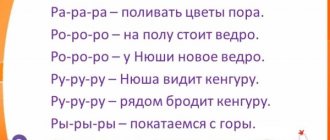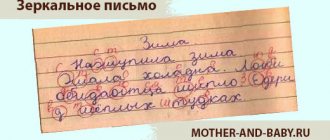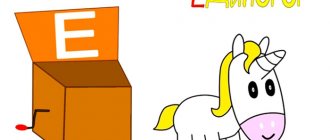Pure sayings starting with the letter D
Doo-do-da - the wires are humming.
Yes, yes, yes - warm water. Doo-doo-doo - I'm not going to sleep. De-de-de - I don’t know where. Di-di-di - sit quietly. Yes, yes, yes, yes, yes, yes - don’t go there, Vadim! Doo-doo-doo, doo-doo-doo - I’ll go there anyway. Di-di-di, di-di-di - you're dressed, don't go! Yes-yes-yes, yes-yes-yes - oh! Cold water! De-de-de, de-de-de - that's the trouble! Vadim, where are you? Dyd-dyd-dyd, dyd-dyed-dyed - you can just hear it from the water.
The woodpecker was pecking at the oak tree, but didn't peck enough. The woodpecker is chiseling the tree, chiseling the bark all day long. The woodpecker heals the ancient oak tree, the kind woodpecker loves the oak tree.
Daria gives Dina melons. A day at Dina’s, two at Dima’s.
Rain, rain, no rain! Rain, rain, wait! Let the gray-haired grandfather reach home!
Tongue twisters starting with the letter T
Home / Children's section / Collections of tongue twisters / Starting with the letter TFunny tongue twisters starting with the letter T that children are sure to love. Tongue twisters, or as they are also called, pure spelling twisters, are most often in demand by speech therapists and parents. Their goal is to teach the child to clearly pronounce and reinforce the problematic sound, in this case, the T sound.
For many children, the letter T is not the most difficult letter, but clear pronunciation of “T” is important not only for diction, but also for the child’s further literacy training.
We also recommend:
With the letter B / With the letter V / With the letter G / With the letter D / With the letter Z / With the letter Z / With the letter K / With the letter L / With the letter M / With the letter N / With the letter P / With the letter P / With the letter S / Starting with the letter F / Starting with the letter X / Starting with the letter C / Starting with the letter Ch / Starting with the letter Sh / Starting with the letter Sh All tongue twisters Complex tongue twisters Russian folk tongue twisters Modern tongue twisters for adult audiences
Tra-ta-ta, tra-ta-ta, we're taking a cat with us. I met a whale in the water of a whale, there was vanity in the ocean. © Tick-tock, tick-tock, the clock ticks like this. © Dark clouds are floating, the clouds are bringing us a thunderstorm. © According to the tariff from a taxi driver from the metro to the theater - three hundred. ©
Dance with stomp near the house, Three tritons danced. © Fat is the one who eats cake. Three magpies, three ratchets. We lost three brushes each. Tolya grew a poplar tree outside the field. Across the field, across the field, Tolya walked towards the poplar. The cockroach lives behind the stove, That's a warm place. Thirty-three cars in a row, chattering and rattling. Thirty-three striped piglets have Thirty-three tails hanging. Tigers are looking at the path, No one can pass there. © From the clatter of hooves, dust flies across the field. Three hundred thirty-three jumps On the athletes' long track. The weaver weaves fabrics onto Tanya's scarves. Three magpies chattered on the hill. The wagtail bird curls, its tail shakes all day. © There is grass in the yard, there is firewood on the grass. Don't cut wood on the grass in your yard. Thirty-three pie pies, all with cottage cheese. The tractor driver looked at the tank, There the tank driver was sitting inside. © Terenty lost his grater. He didn’t grate the crust. Cake plate, Cottage cheese tartlet. To interpret clearly, but to no avail to re-interpret. The river flows, the stove bakes, the stove flows, the stove bakes. Poor Filat, the richer he is, the happier he is. My tiger cub is also a tiger, only small and cute, My tiger cub is a toy, I am very friendly with the tiger cub. © Thirty-three black grouse Let's go to the fields to dance, There will be a ball there today, A carnival of bird dances. © What strange dancers, those who have spurs on their shoes, These are our roosters, roosters’ dancing is dashing. © Tolya wipe the stool with a rag three and three with a napkin. The stool is covered in cake, you need to wipe it everywhere. © The cat watches the TV, like a whale, like a ship sailing. © Only Tanya will get up in the morning. Tanyusha is drawn to dance. Why is it taking so long to explain? Tanya loves to dance. Tolya eats cabbage with a crunch. © Trumpeter Tu-ru-ru trumpeted in the morning. The working people were disturbed by the trumpet. They stomped and stomped, They stomped all the way to the poplar, They stomped all the way to the poplar, and they all trampled their feet. The hammer knocks knock-knock, The ax has a familiar sound, And the ax in the wood Answers with the sound “Fuck.” © Tractors have been rattling in the fields since morning. © Tararam tararam Aunt Tonya is coming to us, There’s bedlam here and there, we’ll wipe it with a rag here and there. © The little one was in a hurry, his little brother was waiting for a visit. © The trumpeters blow their trumpets and wake up the children with their trumpets. © Shadow - the shadow fell on the fence all day, In the morning there is no shadow, everything is in the light of the fence. © Someone ate the entrecote tartlets from the table right away. © There is a cockroach in the corner, the cockroach is no longer there. The cockroach is in a hurry, the kitchen is vacuuming. © TA-TA-TA – we’re bringing a cat TE-TE-TE – wife in a veil TI-TI-TI – we’re on the way TO-TO-TO – play the lotto TU-TU-TU – I’ll grow up TY-TY-TY – little child
Tongue twisters help shape speech and diction. The ability to clearly pronounce words is useful not only for children and representatives of creative, television professions, and the blogosphere. Throughout our lives we communicate with people, at home and at work, clear speech helps to convey information to others and encourage constructive dialogue. If, due to the nature of your activity, you need to speak in front of large audiences, tongue twisters are where you should start preparing for each speech.
Don't forget to share the link with your friends!
Automation of the D sound in words
I. Demyanov 1. A woodpecker heals an ancient oak tree, a good woodpecker loves the oak tree. 2. The woodpecker is chiseling a tree, chiseling the bark all day long. 3. The woodpecker was pecking at the oak tree, but didn’t finish it enough. 4. The woodpecker was hammering the tree and woke up my grandfather with the knock. 5. Dema rode to the house in a sled. I met the drowsy Dema, defeated the drowsy Dyoma, Dyoma is dozing near the house. 6. Grandfather Dodon played the pipe, Grandfather hit Dimka with the pipe. 7. Daria gives Dina melons. 8. Don’t wake the bear - he’ll offend you. 9. In the Dynamo team there is Diana, Diana has dominoes. 10. Vadik, don’t let me down, bring my grandfather to the cart. 11. We’ll see Vadim and we’ll surprise him, but if we don’t see him, we won’t surprise him. 12. Dima is at home alone, but Dima is not at home alone. There is one Dima and two Vadim at home. 13. I don’t divide, Luda, for a week. 14. Is the road expensive? 15. Dali has medals, Dina has orders. 16. Uncle Fyodor has a house in the village, and Goodwin has a house in the city. 17. Lada has water in her bucket, and Dima has a deuce in his diary. 18. There is firewood in the yard, firewood behind the yard, firewood across the width of the yard. The yard will not accommodate firewood. Come out, woodcutter Dron. We need to remove the firewood and put it in the wood yard. 19. There is grass in the yard, there is firewood on the grass; Don't cut wood on the grass in your yard. 20. There is a mountain in the middle of the yard, in the yard there is grass, on the grass there is firewood. 21. There is grass in the yard, there is firewood on the grass: one firewood, two firewood, three yards. Open the gate, Varvara, and chop wood on the grass in the yard. 22. In our yard there is a courtyard. 23. Two woodcutters, two woodcutters, two wood splitters sharpened their axes. The axes are sharp for the time being. Axes are sharp for the time being. Two woodcutters, two woodcutters, two wood splitters chopped down the forest with an ax, turned the forest into firewood. 24. Two woodcutters, two wood splitters, two woodcutters talked about Larya, about Larka, about Larina’s wife (“dr.”). 21. The blanket is in the duvet cover, and the radio is on the windowsill. 25. The hoopoe’s food is with the grandfather, and the grandfather’s hoopoe is with the uncle. 26. Don’t blow your lips on the oak tree, don’t blow your lips on the oak tree. 27. Grandfather Danilo divided the melon - a slice for Dima, a slice for Dina.
Setting and automating the “T” sound
Preparatory stage
Complex of articulatory gymnastics for the sound “T”
(each exercise is performed 5-8 times, counting from 5 to 15; in one lesson, children should not be offered more than 3-4 exercises; exercises are performed from simple to complex; exercises are performed sitting in front of a mirror; of the exercises performed, only one can be new , the rest are given for repetition and consolidation):
Exercise “Fence” : stretch your lips as much as possible (smile), show your upper and lower teeth; The upper teeth are opposite the lower teeth, the distance between them is 1 mm.
Exercise “Pancake” : mouth slightly open, lips not tense, relaxed; a wide, flat pancake tongue rests quietly on the lower lip; hold this position for at least 10 seconds.
Exercise “Brushing your teeth” : open your mouth wide, smile, showing your teeth; use the tip of your tongue to “brush your teeth” from the inside, moving it left and right (first the lower ones, then the upper ones); the tip of the tongue should be behind the teeth; the lips smile all the time, the lower jaw does not move.
Exercise “Horse” : open your mouth slightly, smile, showing your teeth; click your tongue slowly-quickly-slowly; look at the tongue and do not move the lower jaw.
Exercise “Delicious jam” : lick your upper lip from top to bottom with the wide flat tip of your tongue; the lower lip is pulled down, the teeth do not bite the tongue - the lower teeth are visible.
Breathing exercises
Making the sound “T” requires a sharp and strong exhalation, so it is necessary to develop the ability to exhale correctly.
Breathing exercises complex:
Exercise “Snowflake” : smile, open your mouth slightly, place the wide front edge of your tongue on your upper lip so that its side edges are pressed and there is a groove in the middle of the tongue, and blow off the snowflake cotton wool placed on the tip of your nose. The air should go in the middle of the tongue, then the fleece will fly up.
Exercise “Football match” : blow on a cotton ball - “ball”, trying to “score a goal” into the goal (two cubes) - the cotton wool should be between the cubes. Exercise “Feather, fly!”: throw a feather up and blow on it, not letting it fall down. Please note that you need to blow strongly, directing the air stream towards the feather from bottom to top.
Exercise “Pencil” : a pencil lies on the table at a distance of 20 cm from the child; Blow forcefully on the pencil so that it rolls to the opposite edge of the table.
Exercise “Flag”: blow on a paper strip, bringing it to your lower lip (the strip should be held with your thumb and forefinger): turn the paper strips into real flags.
Making the sound "T"
• The lips in a neutral position take the position of the next vowel, • The distance between the teeth is 5 mm. • When pronouncing the vowel sounds A, O, U, Y, the tip of the tongue rests on the upper teeth or alveoli and forms a stop. • The soft palate is raised, the vocal folds are open, the air stream is jerky • Demonstration of the correct position of the lips and tongue: the speech therapist shows the differences in the pronunciation of T (tip of the uvula) and K (tail of the uvula).
• Imitation setting : the speech therapist invites the child to repeat first the syllables and then the words, it is advisable to start with the syllable “ta” (ta-ta-ta, ta-you-to-tu, you-you-you, you-ta-to- that, that-that, that-that-that-you).
• Interdental method: the speech therapist shows the child the position of the tongue (the tongue is pressed between the lips, in this position you need to exhale strongly until you hear a sound, then place the tongue behind the teeth).
• Making the sound “T” from the sound “P” : the child repeats pa-pa-pa, placing the wide tip of the tongue on the lower lip, then, smiling widely, pronounces – P (it turns out – T).
• Production from Ts (reception from the opposite): the sound Ts “hides” two sounds behind itself - s-t.
Pure talk - games for speech, or learning to speak clearly...
All children develop speech differently: for some children, their vocabulary expands quickly, the sound design of words improves, phrases become more developed, but for some children, they cannot do without additional help from the adults around them.
For this reason, it is important to teach your child to pronounce words correctly and clearly, as well as to distinguish and hear the sounds in them. Pure speech is one of the game exercises used to develop children's auditory attention and correct speech perception.
Pure speech is rhythmic speech material that contains complex combinations of words, syllables and sounds that are difficult to pronounce. Pure tongues are also called speech therapy riddles . Such exercises help the child master the intonation of the question and develop their sense of rhythm.
The rhythm and rhymes of these jokes help make the sounds easier to remember and pronounce. The syllabic components of a joke - pure talk - contribute to the formation of correct sound pronunciation, and also stimulate the improvement of auditory perception of speech. For children of younger and middle preschool age, the most suitable are small jokes - pure sayings using pictures and toys.
It should be remembered that in speech games the child is required to apply previously acquired knowledge in new circumstances and connections. But those who can help him in this task are his parents, grandparents - his closest and first educators and mentors.
Why are pure words needed?
Formation of correct sound pronunciation and expressiveness of speech.
The use of pure tongues is quite often one of the particularly effective methods of practicing and consolidating sounds in speech. It is noteworthy that, along with ready-made options, you can come up with words for the sound you are studying, create phrases and phrases for them. In order to automate sound, develop clear diction, articulatory motor skills and expressiveness of speech, children's speech therapists recommend pronouncing each phrase several times, while performing a variety of tasks.
For example, when automating the sound [C], a pure saying is used: “Sa-sa-sa - the sly fox is coming.” Types of tasks:
Automation of sounds, work on diction and expressiveness
- say it loudly or quietly;
- we pronounce it with different intonation (exclamatory, interrogative, sad, etc.);
- we pronounce at different tempos (fast or slow);
- we pronounce it, changing the logical place of stress (we knock on different words with a hammer);
- We pronounce it in a voice of different timbre (like a mouse or like a bear).
Development of phonemic perception, syllabic, sound synthesis and analysis.
Pure phrases help to attract the child’s attention to the sounding word, its syllabic and sound composition.
Types of tasks:
- Let's walk through the syllables: Cha-cha-cha - na-sha ka-sha hot-rya-cha.
La-la-la - ost-ra-ya p-la. Shh-sh-sh-shche - when it rains, we wear a raincoat, etc. - Add a syllable with a certain sound: Sy-su-so - a wheel rolled... (so).
Su-sa-sy - the girl has two ears... (sy).
Sy-so-sa - polo on paper... (sa). Sa-so-su - I don’t give flowers to my mother... (su), etc.
- We repeat without mistakes: Za-zha, za-zha - the hedgehog has needles.
Sha-cha, sha-cha - Tanyusha has two balls
Su-shu, sushu - I’m writing a letter, etc. - Let’s finish the pure saying (we select words with the appropriate syllable): Cha-cha-cha - (thickness, heap, dry land)? Cha-cha-cha - a bunch.
Ro-ro-ro – (bucket, paddle, right)? Ro-ro-ro - bucket.
Sa-sa-sa - ... (porridge, goat, scythe)? Sa-sa-sa - braid, etc. - Let's change the sounds: “sh” to “s”: Sha-sha-sha - roof. Sa-sa-sa is a rat.
“l” to “r”: Al-al-al – ball. Ar-ar-ar - bar.
Improving lexical-grammatical structure and coherent speech.
Using the universal material of pure proverbs, it is possible to teach a child to change the form of a word and form words, use prepositions and coordinate words with each other, compose simple sentences¸ as well as short stories.
Types of tasks: - We change the form of the word: Sy-sy-sy - two ... (foxes) came running.
Sa-sa-sa - here comes again... (fox). Is-is-is - there are a lot of... (foxes) in the forest. Su-su-su - the children saw... (a fox).
Se-se-se - there are many tales about ... (fox). Soy-soy-soy - the wolf chased ... (fox), etc.
- We name words that have the opposite meaning: Ra-ra-ra - high mountain. Ra-ra-ra is a low mountain. Ro-ro-ro - a full bucket. Ro-ro-ro - empty bucket, etc.
— We answer the question in plain language (you can use diagrams, pictures): La-la-la - where is the top? La-la-la - there is a top in the table, a top under the table, a top on the table, etc.
— We answer the question (signs, actions) in plain language: Ra-ra-ra - what is the child doing? Ra-ra-ra - children play, sing, dance, etc.
Ra-ra-ra - what kids? Ra-ra-ra - cheerful, noisy, friendly kids, etc. — We select a word with a given sound (based on words-signs): Sa-sa-sa - cunning, red-haired, fluffy? Sa-sa-sa is a fox. - We call the words “affectionately”: Re-re-re - a spark in the fire. Re-re-re is a spark in the fire.
Lu-lu-lu - a chair in the corner. Lu-lu-lu - a chair in the corner, etc.
We come up with a story based on a picture or questions:
Sa-sa-sa - what fox? Sa-sa-sa is a red fox.
Sa-sa-sa - who is this? Sa-sa-sa is a fox.
Sa-sa-sa - who did the fox meet? Sa-sa-sa - the wolf was met by a fox. Sa-sa-sa - what is the fox doing? Sa-sa-sa - a fox walks through the forest, etc.
The effectiveness of using pure phrases to automate sounds increases in preschoolers and schoolchildren with the use of tactile-kinesthetic stimulation. So, for example, to differentiate between hissing and whistling sounds, you can give a child a block of wood (sound [C]) in one hand, and a cone (sound [Ш]) in the other hand and pronounce the mixed sounds, pressing each stimulus in turn, influencing thereby affecting the speech-motor and speech-auditory analyzers. These exercises allow you to develop tactile sensitivity, enhance kinesthetic sensations and improve fine motor skills.





